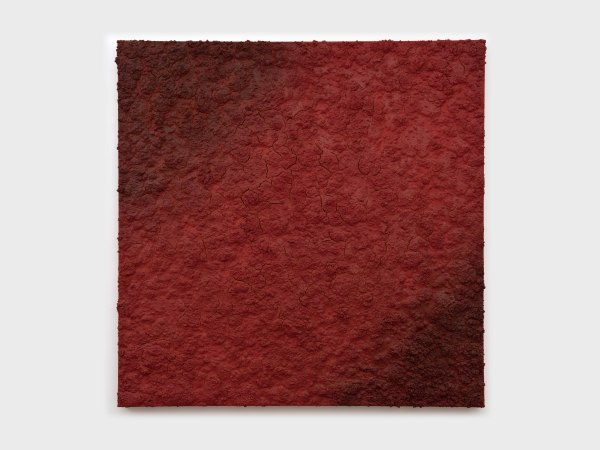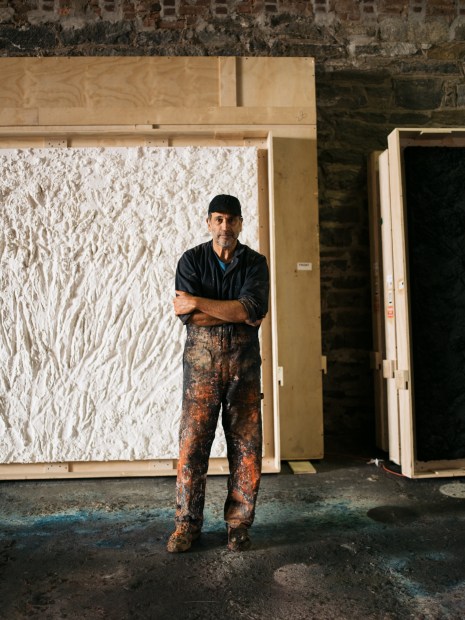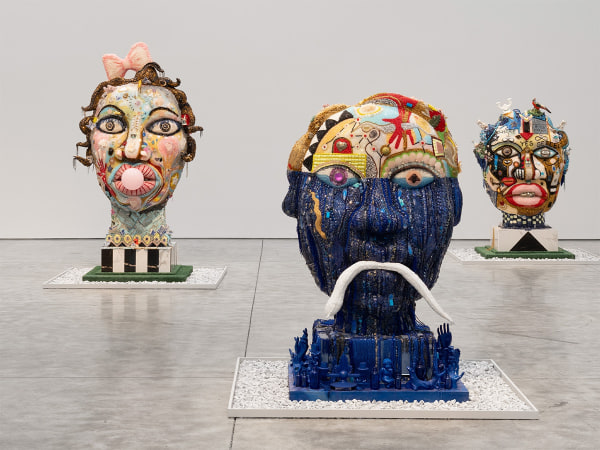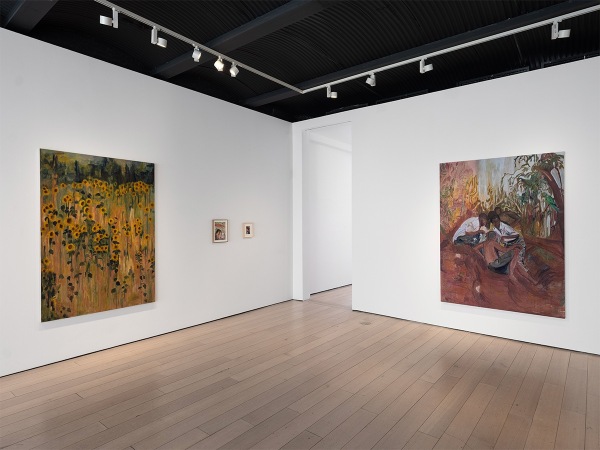Bosco Sodi: Solo Para Revivir
-
-
Bosco Sodi’s third solo exhibition at Kasmin, Solo Para Revivir, presents new works in an ambitious installation exploring the compelling material and conceptual relationships between the artist’s painting and sculpture. Sodi’s deepening investigations into the symbolic power of four elemental colors—black, purple, red, and green—are expressed in several large-scale mixed media paintings imbued with impressions of nature: indented with the fractal structure of tree branches drawn from the surroundings of the artist’s studio, or subjected to the pull of gravity as they dry.
Rendered in powerful, saturated hues, Sodi’s paintings are grounded in the exhibition by three freestanding clay spheres and a monumental oil painting realized on a canvas of twelve interwoven burlap sacks. Furthering the artist’s recent focus on the stages of life, Solo Para Revivir translates to ‘only to wake’, metaphorically reinforcing the incessant, even primal, drive at the heart of the creative instinct, and how this impulse is mirrored in the cycles of the natural world. Engaging with the most fundamental materials and forms, Sodi prompts reflections on the innate, ineffable structures of our universe; our interdependence with our environment; and the artistic interventions that are able to transform physical matter into signifiers of the non-corporal world.
-
-
The artist’s long standing engagement with color, a primary and essential aspect of his practice, stems from both a somatic response to certain pigments and a scholarly interest in the resonance of color in cultural and political histories worldwide. For this body of work, Sodi focuses on black, red, purple, and green as markers of quintessential, cardinal facets of life. The idea of green as a vivid invocation of life force has roots in Egyptian, Roman and Medieval history, with the color’s affinity for attracting allegorical meaning linked to its prevalence in the natural world. Red, the essence of fire and the sun, has remained a significant color to Sodi as it encapsulates the history of pre-Columbian art, Aztec innovation, colonialist oppression, and international trade. Purple and black act to denote the fifth element or quinta essencia, considered in ancient philosophy to compose the celestial bodies.
Sodi’s painting process is celebrated for its intense, improvisatory physicality. Working paper and pigment using his hands, the artist intuitively applies what Matthew J. Abrams has termed Sodi’s “color-matter” onto the supine canvas in brisk, forceful gestures. Balancing control and disorder; matter and lightness; minimalism and automatism, Sodi assembles the work’s preconditions to allow his material to express its ultimate form—collaborating with the environment to do so. The resulting paintings are consequently “landscapes, in a way, abstract landscapes, visions of nature, allegories of the tree swaying in the wind,” as referenced by Juan Manuel Bonet, former director of Museo Nacional Centro de Arte Reina Sofía and Instituto Valenciano de Arte Moderno (IVAM).
-
-
In Solo Para Revivir, Sodi’s phenomenological inquiries are echoed in three clay sphere sculptures situated in the center of the gallery space. One is left unglazed, one is glazed in gold, and one is broken open with a single seed of corn inside that will germinate and grow during the run of the exhibition. All three are rendered from Oaxacan clay which has been mined, prepared, shaped, and fired using local, pre-industrial techniques at Sodi’s studio in Puerto Escondido. Here, the works are presented in three material iterations to illuminate the profound transformations enacted by the simplest artistic gesture. While raw clay reveals the effects of nature—sun, sea, air, and fire—through unplanned cracks and other welcome imperfections, in contrast, gold remains an alchemical material that signifies holiness and revelation. The embedded corn, a direct reference to the artist’s Tabula Rasa (presented in Washington Square Park, New York, 2021, and at Art Basel Parcours, Switzerland, 2022) enacts a biological imperative to grow towards light, forming new fissures in its host sculpture as it evolves.
-
-
These themes of dislocation and the unity of human experience were further explored in What Goes Around Comes Around in Venice. At the Palazzo Vendramin Grimani, Sodi presented monumental canvases alongside a series of ceramic spheres, each representing a different nation. Viewers were encouraged to move the spheres across the room during the course of the installation. Following the Russian invasion of Ukraine in February 2022, Sodi added a large sphere to the center of the installation, representing humanity and gesturing to his hope for global peace. Following the close of the exhibition, residents of Venice were invited to take the spheres home.
Sodi’s invocation of the planting and harvesting cycles that humanity has long relied upon is reiterated in his sack paintings. Beginning in 2020, without access to his usual canvases while in quarantine in Puerto Escondido, Sodi found new use for heavily aged objects at his disposal: dry burlap chili sacks. Used to distribute agricultural harvests, Sodi found this material an ideal substrate for a new painting series. In the initial stages of the lockdown, Sodi rendered one “Sun Painting”—a circle over a burlap sack—per day, instancing a record of his isolation period. As if to offer a counterbalance, the work on view depicts a blue circle over twelve burlap sacks, gesturing toward elemental associations with water while recalling the lunar calendar’s primacy in pre-industrial societies.
-
WORKS
-
About the Artist
 Portrait by Spencer Wells.
Portrait by Spencer Wells. -
Explore
-

vanessa german: GUMBALL—there is absolutely no space between body and soul
April 3 – May 10, 2025 509 West 27th Street, New York, 514 West 28th Street, New YorkKasmin presents its second solo exhibition of new work by artist vanessa german (b. 1976), which debuts related bodies of sculpture across two of the gallery’s spaces in New York. GUMBALL—there is absolutely no space between body and soul deepens german’s singular approach to sculpture as a spiritual practice with the power to transform lived experience. Both series comprise mineral crystals, beads, porcelain, wood, paint and the energy that these objects bring to life to form monumental heads and figures in the act of falling. Together, each body of work envisions the transformation of consciousness necessary to imagine a new world. -

Helena Foster: Time Honoured
April 3 – May 3, 2025 297 Tenth Avenue, New YorkThe first New York solo exhibition of London-based painter Helena Foster features new oil paintings on linen, paper, and vellum that express the artist’s lyrical approach to painting as an accumulation of cultural and generational wisdom. Foster draws freely from literature, theater, film, Igbo oral tradition, and religion, achieving a dreamlike aura of mystery in dynamic compositions ambiguously set between thick vegetation and the built environment.
-
































